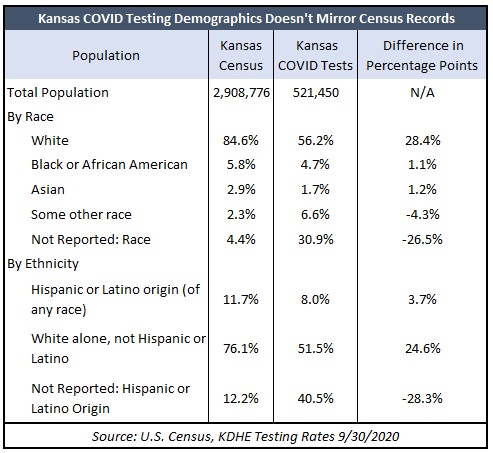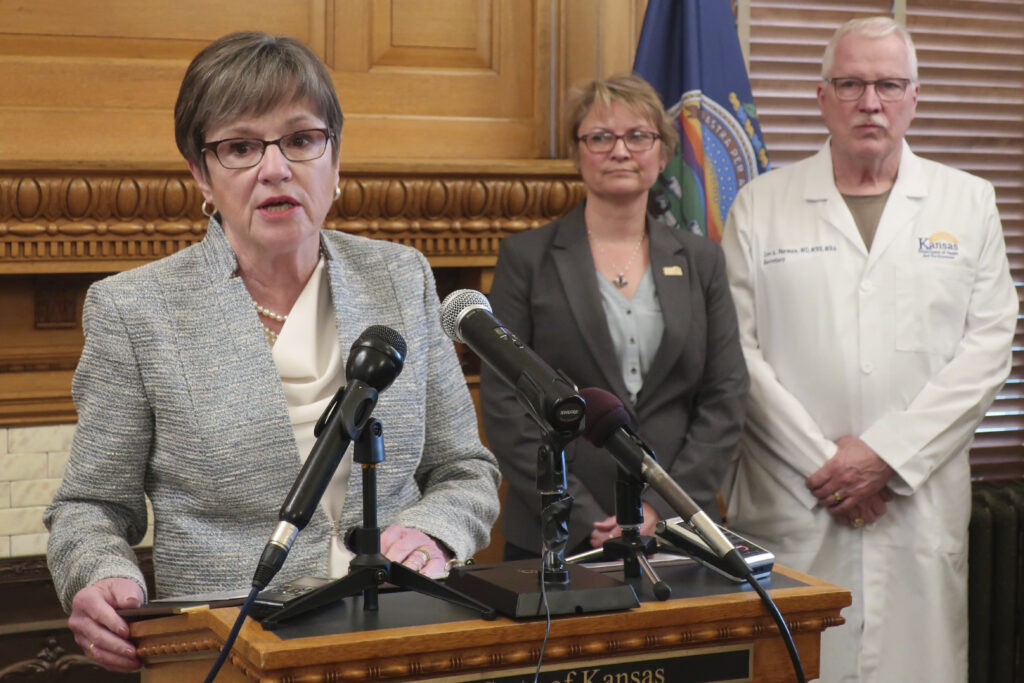Gov. Kelly and officials around the state won’t restore COVID-19 freedoms until the state’s positivity rate is below an arbitrary threshold. However, Kansans should have skepticism when public health officials focus entirely on mass COVID testing and lowering positivity rates. COVID testing in Kansas is replete with false positives, skewed testing samples, supply chain issues, and weak connections to COVID hospitalizations and deaths. Unless state officials address these concerns, Kansans won’t see their freedoms restored or see in-person schooling until 2021 at the earliest.
Reason 1: Kansas COVID tests are too sensitive, potentially 25% of COVID cases are false positives
The gold standard of COVID testing in Kansas and the nation is known as the Polymerase Chain Reaction (PCR) test. It works by finding hints of COVID-19 and amplifying (cycles) to make “positive” case results. Research studies, the New York Times, and even the CDC note that PCR tests that amplify COVID material more than 34 cycles aren’t finding a viable COVID virus. In other words, the individual isn’t contagious.
According to evidence uncovered by The Sentinel, state labs calibrate COVID tests to 42 cycles. They also found two major private COVID testing labs calibrated their tests at or above 38 cycles. It’s important because 24% percent of Kansas COVID tests conducted come from state labs. Add in the two private labs, and up to 25% of all COVID cases are false positives. Kansas officials are using these cases to surmise there is community spread, when, in some areas, it does not exist.
Reason 2: Kansas COVID tests skewed samples, pushing rates high
Kansas’s current COVID testing regime suffers from what statisticians call convenience bias. A good example is taking a poll to find the best college basketball team in Kansas, but the sample only consists of Lawrence residents. In terms of COVID, the state “takes a poll” of COVID positivity but samples those with a reasonable suspicion they already have the virus. In July, the state tested 120,931 Kansans with an 8.0% test positivity rate. By September, tests administered fell roughly 23%, but the COVID positivity rate dropped 0.8 percentage points. While it’s unclear if testing policy changed, the large fall in tests with a roughly-constant positivity rate strongly suggests a priority to people with known COVID exposure. While it’s good to identify COVID-positive individuals, it doesn’t tell us how prevalent COVID-19 is across the state or a given community. Here’s an example.
 The adjacent table compares Kansas testing demographics to Kansas Census demographics. If Kansas testing was representative of the Kansas population, then it should generally reflect the community demographics. To be clear, testing at-risk or vulnerable people is essential. However, decisions about schools, reopening, etc. should have a basis from a testing regime representing the entire state population. Under the CARES Act, all COVID testing laboratories must include age, sex, race, and ethnicity of the person tested. However, KDHE publicly reports tests only by race and ethnicity and hasn’t responded to our age and gender request. However, even by limited testing demographics, Kansas COVID tests do not reflect the state’s demographic makeup.
The adjacent table compares Kansas testing demographics to Kansas Census demographics. If Kansas testing was representative of the Kansas population, then it should generally reflect the community demographics. To be clear, testing at-risk or vulnerable people is essential. However, decisions about schools, reopening, etc. should have a basis from a testing regime representing the entire state population. Under the CARES Act, all COVID testing laboratories must include age, sex, race, and ethnicity of the person tested. However, KDHE publicly reports tests only by race and ethnicity and hasn’t responded to our age and gender request. However, even by limited testing demographics, Kansas COVID tests do not reflect the state’s demographic makeup.
Roughly 85% of the Kansas population is “White,” but “Whites” only 56.2% of all Kansas COVID tests. Additionally, approximately 12% of the Kansas population is of Hispanic or Latino ethnicity, but only 8% of COVID tests. To clarify, we are not saying a race or ethnicity is or should be, predisposed to COVID. Instead, Kansas COVID tests don’t reflect all Kansans, yet serve as the basis of the policy that impacts all Kansans.
Reason 3: Gov. Kelly’s influx of rapid COVID tests aren’t entirely effective until January 2021
Gov. Kelly announced her administration would receive nearly 900,000 rapid COVID tests to supplement Kansas’s current PCR test regime. These rapid tests, unlike PCRs, detect COVID-19 antibodies as opposed to catching the virus itself. The test costs $5 to administer and requires no proprietary laboratory equipment. However, while rapid COVID tests show considerable promise, such a strategy may not lower test positivities until 2021.
Last week, Gov. Kelly noted Kansas wouldn’t have all 870,000 rapid tests until next year. Additionally, the approved $50 million in Kansas COVID testing funds has no timetable for distribution. What’s more, state regulations will only delay further, which COVID testing organizations will receive the money. Despite the promise of expanded, rapid tests, there is little near-term hope that such a strategy will lift COVID-restrictions on our freedom anytime soon. Under the Governor’s plan, the Kansas positivity rate may not fall below-mandated thresholds until half of the current school year is over.
Reason 4: Relationship between COVID cases & hospitalizations is weakening
Remember, the initial goal of COVID health policy was to keep hospitalizations and death rates low and manageable. A popular refrain in April and May was “14 days” to flatten the curve. The focus on reducing cases remains that fewer cases mean fewer hospitalizations, preserving scarce resources, and, ultimately, minimizing fatalities. However, today’s emphasis on COVID case numbers ignores reality. COVID severity metrics are on the decline.
Hospitalizations and deaths as a share of cases are falling in Kansas. As of writing this, hospitalizations are at a new low of 4.88%, and fatalities are at 1.14%. The growth rate of COVID cases is larger than the growth rate of hospitalizations and deaths. The status of COVID cases as a leading indicator of COVID severity is weakening. Why? One reason is the skewed testing sample noted previously. It strongly suggests that Kansas public health policy is perhaps better off following hospitalizations, ICU or ventilator usage, and fatalities than focusing solely on cases.
In South Dakota, Governor Kristi Noem has noticed the same pitfalls and has adjusted her success metric to state hospitalizations.
We have known for months that there were days we would see increased cases. What we’re continuing to focus on at the state level is how many people we have in the hospital, and we’re still in really good shape in that area.
Mass COVID testing is not a silver bullet. Kansas, indeed, America, might have been much better served if our leaders leveled with us. Serve Kansans by providing sober realities and reasons for hope throughout this pandemic. The truth is that Kansas policy officials are wasting time, resources, and our freedoms by avoiding the simple solution. We must stop relying on COVID cases as a metric of success/failure. We must be honest with Kansans and fight COVID-19, simultaneously preserving Kansans’ health and livelihoods.





